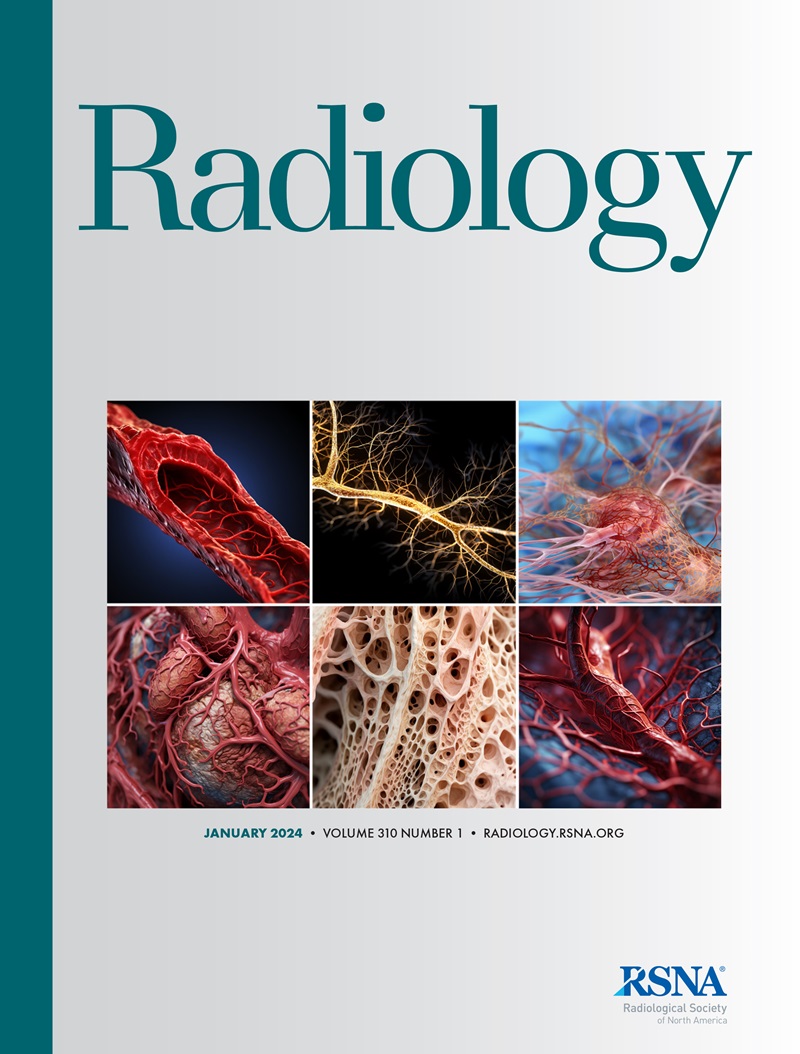SARS-CoV-2 Infection Association with Atherosclerotic Plaque Progression at Coronary CT Angiography and Adverse Cardiovascular Events.
Neng Dai, Xianglin Tang, Yiqing Hu, Hao Lu, Zhangwei Chen, Shaofeng Duan, Weifeng Guo, Pranav Prakash Edavi, Yongfu Yu, Dong Huang, Juying Qian, Junbo Ge
求助PDF
{"title":"SARS-CoV-2 Infection Association with Atherosclerotic Plaque Progression at Coronary CT Angiography and Adverse Cardiovascular Events.","authors":"Neng Dai, Xianglin Tang, Yiqing Hu, Hao Lu, Zhangwei Chen, Shaofeng Duan, Weifeng Guo, Pranav Prakash Edavi, Yongfu Yu, Dong Huang, Juying Qian, Junbo Ge","doi":"10.1148/radiol.240876","DOIUrl":null,"url":null,"abstract":"<p><p>Background Patients with acute SARS-CoV-2 infection are reportedly at increased risk for future cardiovascular events; the mechanism underlying this risk remains unclear. Purpose To evaluate the impact of SARS-CoV-2 infection on coronary inflammation and plaques by using coronary CT angiography (CCTA) and the impact on clinical outcomes. Materials and Methods This retrospective analysis of a prospective study included consecutive patients who underwent serial CCTA between September 2018 and October 2023. The quantitative total and compositional percent atheroma volume (PAV) and annualized PAV change, presence of high-risk plaque, and attenuation of lesion-specific pericoronary adipose tissue (PCAT) at baseline and follow-up were compared between lesions in patients with and without SARS-CoV-2 infection. Relationships between SARS-CoV-2 infection and target lesion failure, which is a composite of cardiac death, target lesion myocardial infarction, and clinically driven target lesion revascularizations, were assessed with Cox models and log-rank tests. Results In 803 patients (mean age, 63.9 years ± 10.1 [SD]; 543 [67.6%] male patients), 2108 coronary artery lesions were evaluated in patients with SARS-CoV-2 infection (<i>n</i> = 690) and 480 coronary artery lesions were evaluated in patients without SARS-CoV-2 infection (<i>n</i> = 113). Compared with lesions in patients without SARS-CoV-2 infection, lesions in patients with SARS-CoV-2 infection demonstrated more rapid progression of overall PAV (0.90% per year ± 0.91 vs 0.62% per year ± 0.68, respectively; <i>P</i> < .001) and noncalcified PAV (0.78% per year ± 0.79 vs 0.42% per year ± 0.45, respectively; <i>P</i> < .001). The incidence of becoming high-risk plaque (21.0% [442 of 2108] vs 15.8% [76 of 480]; <i>P</i> = .03) and PCAT attenuation of -70.1 HU or higher (27.1% [571 of 2108] vs 19.8% [95 of 480]; <i>P</i> < .001) at follow-up was also greater in lesions in patients with SARS-CoV-2 infection (<i>P</i> < .001), despite similar prevalence at baseline. Lesions in patients with COVID-19 had a higher risk of target lesion failure (10.4% vs 3.1%, respectively; adjusted hazard ratio, 2.90; 95% CI: 1.68, 5.02; <i>P</i> < .001). Conclusion SARS-CoV-2 infection was associated with a more rapid progression of lesion-based plaque volume and an increase in incidence of becoming high-risk plaque. Coronary plaques among patients who experienced COVID-19 were more prone to having an elevated risk of target lesion failure. Clinical trial registration no. NCT05380622 © RSNA, 2025 <i>Supplemental material is available for this article.</i> See also the editorial by Weir-McCall and Bell in this issue.</p>","PeriodicalId":20896,"journal":{"name":"Radiology","volume":"314 2","pages":"e240876"},"PeriodicalIF":12.1000,"publicationDate":"2025-02-01","publicationTypes":"Journal Article","fieldsOfStudy":null,"isOpenAccess":false,"openAccessPdf":"","citationCount":"0","resultStr":null,"platform":"Semanticscholar","paperid":null,"PeriodicalName":"Radiology","FirstCategoryId":"3","ListUrlMain":"https://doi.org/10.1148/radiol.240876","RegionNum":1,"RegionCategory":"医学","ArticlePicture":[],"TitleCN":null,"AbstractTextCN":null,"PMCID":null,"EPubDate":"","PubModel":"","JCR":"Q1","JCRName":"RADIOLOGY, NUCLEAR MEDICINE & MEDICAL IMAGING","Score":null,"Total":0}
引用次数: 0
引用
批量引用
Abstract
Background Patients with acute SARS-CoV-2 infection are reportedly at increased risk for future cardiovascular events; the mechanism underlying this risk remains unclear. Purpose To evaluate the impact of SARS-CoV-2 infection on coronary inflammation and plaques by using coronary CT angiography (CCTA) and the impact on clinical outcomes. Materials and Methods This retrospective analysis of a prospective study included consecutive patients who underwent serial CCTA between September 2018 and October 2023. The quantitative total and compositional percent atheroma volume (PAV) and annualized PAV change, presence of high-risk plaque, and attenuation of lesion-specific pericoronary adipose tissue (PCAT) at baseline and follow-up were compared between lesions in patients with and without SARS-CoV-2 infection. Relationships between SARS-CoV-2 infection and target lesion failure, which is a composite of cardiac death, target lesion myocardial infarction, and clinically driven target lesion revascularizations, were assessed with Cox models and log-rank tests. Results In 803 patients (mean age, 63.9 years ± 10.1 [SD]; 543 [67.6%] male patients), 2108 coronary artery lesions were evaluated in patients with SARS-CoV-2 infection (n = 690) and 480 coronary artery lesions were evaluated in patients without SARS-CoV-2 infection (n = 113). Compared with lesions in patients without SARS-CoV-2 infection, lesions in patients with SARS-CoV-2 infection demonstrated more rapid progression of overall PAV (0.90% per year ± 0.91 vs 0.62% per year ± 0.68, respectively; P < .001) and noncalcified PAV (0.78% per year ± 0.79 vs 0.42% per year ± 0.45, respectively; P < .001). The incidence of becoming high-risk plaque (21.0% [442 of 2108] vs 15.8% [76 of 480]; P = .03) and PCAT attenuation of -70.1 HU or higher (27.1% [571 of 2108] vs 19.8% [95 of 480]; P < .001) at follow-up was also greater in lesions in patients with SARS-CoV-2 infection (P < .001), despite similar prevalence at baseline. Lesions in patients with COVID-19 had a higher risk of target lesion failure (10.4% vs 3.1%, respectively; adjusted hazard ratio, 2.90; 95% CI: 1.68, 5.02; P < .001). Conclusion SARS-CoV-2 infection was associated with a more rapid progression of lesion-based plaque volume and an increase in incidence of becoming high-risk plaque. Coronary plaques among patients who experienced COVID-19 were more prone to having an elevated risk of target lesion failure. Clinical trial registration no. NCT05380622 © RSNA, 2025 Supplemental material is available for this article. See also the editorial by Weir-McCall and Bell in this issue.


